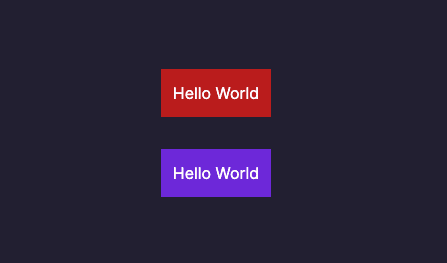Tailwind Dynamic Class Names
For my fellow Tailwind and React enthusiasts, have you ever tried to dynamically apply the class names based on the props that you receive in your component? 🤔
Let's say we have a component called CustomButton.
const CustomButton = ({color}) => {
return (
<button className={`bg-${color}-700`}>
Hello World
</button>
);
}
Here, CustomButton is a reusable component that receives color as a prop. The idea is to dynamically style the button's background color based on the prop it receives.
Now, let's use two instances of CustomButton within a ButtonContainer component.
const ButtonContainer = () => {
return (
<>
<CustomButton color="red"/>
<CustomButton color="violet"/>
</>
)
}
The first one has color="red" as a prop, and the second one has color="violet" as a prop.
The idea is that the first button will have the bg-red-700 class name, and the second one will have the bg-violet-700 class name. So, the expected result is that the first button will have a red background color, and the second one will have a violet background color.
The code seems good, so let's check the result ... 🥁🥁🥁

It didn't work. 🤯🤯🤯
We do know that bg-red-700 and bg-violet-700 are valid Tailwind class names. But those two buttons didn't have the background color that we expected.
Hmm, why does this happen? 🤔

This is actually one of the common gotcha when using Tailwind. The reason is that Tailwind can only detect classes that exist as complete unbroken strings in our source code.
The keyword is: complete unbroken strings.
Let's look once again at how we dynamically apply the class name to our button.
<button className={`bg-${color}-700`}>
Hello World
</button>
As we see in the code above, we dynamically apply the class name using a template literal. Even though the result of the template literal is bg-red-700 and bg-violet-700, those class names don't exist as complete unbroken strings , and Tailwind doesn't allow us to do that. 😢
To address this, let's consider this straightforward solution:
const ButtonContainer = () => {
return (
<>
<CustomButton color="bg-red-700"/>
<CustomButton color="bg-violet-700"/>
</>
)
}
const CustomButton = ({color}) => {
return (
<button className={`${color}`}>
Hello World
</button>
);
}
Here, we pass the complete class name as a prop to the CustomButton component, ensuring our classes exist as complete unbroken strings.
Let's check the result … 🥁🥁🥁

Done! It works as expected now! 🎉🎉🎉
Just remember the keyword: complete unbroken strings 😉
Congratulations on learning this new tip today! 😄
further reading: